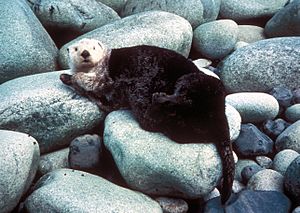Yukon Delta National Wildlife Refuge facts for kids
Quick facts for kids Yukon Delta National Wildlife Refuge |
|
|---|---|
|
IUCN Category IV (Habitat/Species Management Area)
|
|

Brant goose nesting area
|
|
| Location | Alaska, United States |
| Nearest city | Bethel, Alaska |
| Area | 19.16 million acres (77,500 km2) |
| Established | 1980 |
| Governing body | U.S. Fish and Wildlife Service |
| Website | Yukon Delta NWR |
The Yukon Delta National Wildlife Refuge is a huge protected area in southwestern Alaska, United States. It covers about 19.16 million acres (77,500 square kilometers). This makes it the second-largest National Wildlife Refuge in the entire country. Only the Arctic National Wildlife Refuge is a little bigger.
This special place is a flat coastal plain that stretches out to the Bering Sea. It includes the large delta formed by the Yukon and Kuskokwim rivers. This delta has many wetlands (swampy areas) that are close to sea level. The ocean tides from the Bering Sea often cover these wetlands. To its east, the refuge touches Wood-Tikchik State Park, which is the biggest state park in the U.S. The main office for the refuge is in Bethel.
Contents
How the Refuge Started
The idea for protecting this land began a long time ago. In 1909, U.S. President Theodore Roosevelt first set aside some lands in southwestern Alaska. Over the years, more areas were added to this protected region.
A big step happened on December 2, 1980. On this day, President Jimmy Carter signed a very important law. It was called the Alaska National Interest Lands Conservation Act (ANILCA). This law officially created the Yukon Delta National Wildlife Refuge. It did this by combining older protected areas and adding new lands.
Two large islands, Nelson Island and Nunivak Island, are also part of this refuge. In 1968, a part of the refuge, then called the Clarence Rhode National Wildlife Range, was named a National Natural Landmark. This means it's a special place recognized for its natural features.
People of the Refuge
About 35 villages are located within the refuge, and around 25,000 people live there. Many of these people are of Yup'ik Eskimo origin. They often live a subsistence lifestyle. This means they rely on hunting, fishing, and gathering food directly from the land to survive.
Amazing Wildlife and Habitats

The coastal part of the refuge, which borders the Bering Sea, is a very rich place for animals. It's a key habitat that supports one of the largest groups of water birds in the world. This national wildlife refuge is home to many different kinds of animals.
Mammals of the Refuge
You can find many mammals here, including:
- Muskrats
- Brown bears
- Muskoxen
- Moose
- Black bears
- Coyotes
- Canadian lynx
- Porcupines
- Beavers
- Two types of foxes
- River otters
- Martens
- Wolverines
- Mink
- Polar bears
- Wolf packs
Birds and Their Reproduction
More than one million ducks and half a million geese use this area every year. They come here especially for breeding and raising their young. There are also huge groups of other birds that visit seasonally. These include northern pintails, loons, grebes, swans, and cranes.
Other Animals
Sometimes, over 150,000 caribou from the Mulchatna herd move onto the eastern tundra areas. This usually happens during the fall and winter months. In the waters of the refuge, you can spot marine animals too. These include Walruses, seals, and porpoises. Larger sea creatures like beluga whales, gray whales, and minke whales also swim in these waters.

